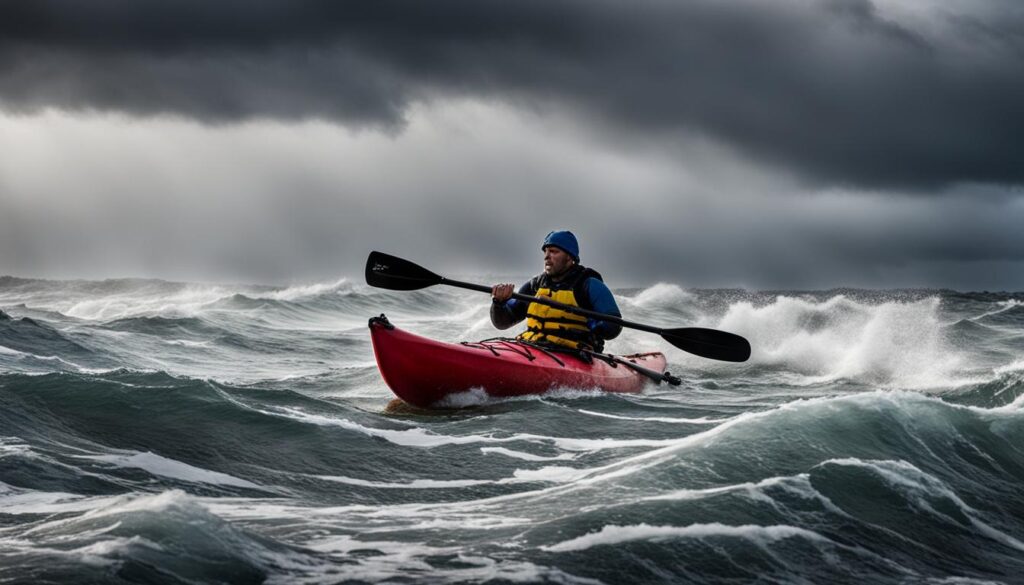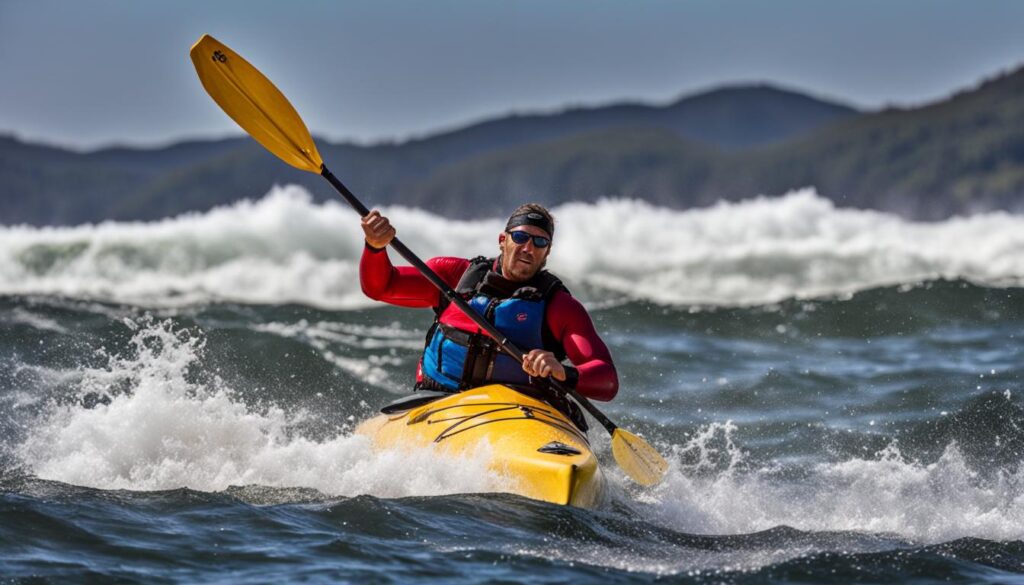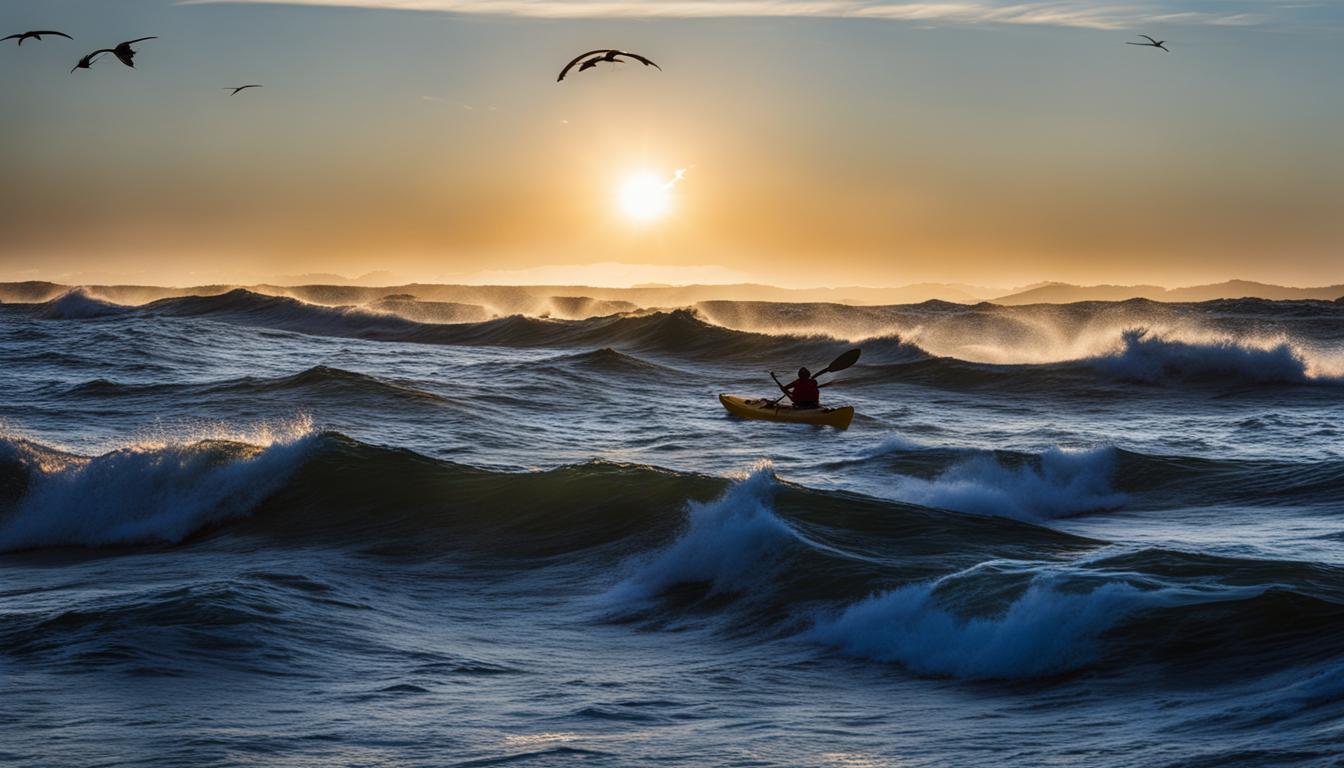When it comes to kayaking, windy conditions can present a challenge, especially when waves and surf are involved. Understanding how to navigate these conditions is crucial for a safe and enjoyable kayaking experience. In this article, we will dive into the techniques and precautionary measures you need to know to handle waves and surf in windy kayaking conditions.
Key Takeaways:
- Knowing the forecasted wind direction and speed is vital for kayakers.
- Light winds up to 5km/h may require adjustments, while winds between 6-10km/h can create waves up to 1m.
- Wind speeds of 11-19km/h can generate whitecaps and dangerous waves up to 1.5m.
- Wind speeds exceeding 20km/h should be avoided due to the potential for waves higher than 2m.
- Proper safety gear, such as a towline and PFD, is essential for kayaking in windy conditions.
Precautionary Measures for Windy Kayaking Conditions
When kayaking in windy wave conditions, it is crucial to take precautionary measures to ensure your safety and the safety of others. Properly equipping yourself with the right kayaking safety gear is essential. Some essential items to carry include a towline, paddle float, spare paddle, communication devices, whistle, and a personal floatation device (PFD). These tools can help you navigate through challenging conditions and handle any emergencies that may arise.
Another important aspect is to wear suitable clothing that matches the weather conditions. In colder weather, a dry suit can help keep you warm and protected. It is also important to stay hydrated throughout your kayaking trip by carrying enough water with you.
Creating and sharing a float plan is highly recommended. This plan should include details of your route, launch/return times, members of your kayaking group, and any contingency plans for emergencies. By having a well-thought-out plan, you can ensure that someone knows your whereabouts and can take appropriate action in case of any unforeseen circumstances.
Additionally, it is important to assess your personal and group limitations in terms of skill level and equipment. A thorough risk assessment should be conducted by considering weather forecasts, the topography of the kayaking location, and any guidelines or recommendations from local authorities. This will help you make informed decisions and minimize any risks associated with kayaking in windy wave conditions.

Kayaking Safety Gear Checklist
| Item | Description |
|---|---|
| Towline | A strong rope or strap used to tow or be towed by other kayakers in case of emergencies. |
| Paddle Float | An inflatable device that attaches to your paddle blade to serve as an outrigger for stability during re-entry after capsizing. |
| Spare Paddle | An additional paddle in case your primary paddle gets lost or damaged. |
| Communication Devices | Devices such as a VHF radio or a waterproof phone case to stay connected and call for help if needed. |
| Whistle | A small and compact device that can be used to attract attention and signal for help. |
| Personal Floatation Device (PFD) | A life jacket or PFD that fits properly and provides buoyancy and flotation support in case of accidental immersion. |
By adhering to these precautionary measures and ensuring you have the necessary safety gear, you can have a safe and enjoyable kayaking experience even in challenging windy conditions.
Techniques for Paddling Canoes in Wind and Waves
When it comes to handling wind and waves while canoeing, mastering the right techniques is crucial for maintaining stability and control. Whether you’re a beginner or an experienced paddler, these techniques will help you navigate challenging conditions and enjoy your canoeing adventure to the fullest.
Canoe Paddle Strokes
Proper paddle strokes play a significant role in handling wind and waves. The J-stroke and the pry are two essential paddle strokes to familiarize yourself with. The J-stroke is used to maintain a straight course by combining a forward stroke with a slight outward movement at the end, creating a “J” shape. The pry stroke, on the other hand, helps you steer the canoe and correct your course by pushing the paddle blade against the water. Practice these strokes to improve your control and maneuverability in windy and wavy conditions.
Canoe Stability
Maintaining stability is key when paddling in wind and waves. To achieve optimal stability, distribute your weight low and centered in the canoe. Sit on the front edge of the seat with your knees on the floor, allowing you to use your lower body as a stabilizing force. This seating position helps you respond to the movement of the canoe and keep it balanced. Remember to engage your core muscles and maintain an active posture to further enhance stability.
Tacking Route
In windy conditions, utilizing a tacking route can be an effective strategy for maintaining a good angle into the waves. By zig-zagging towards your destination, you can better navigate through the waves while reducing the impacts of wind and maintaining stability. This technique allows you to approach the waves at a 45º angle, minimizing the chance of water splashing over the bow and increasing your overall stability.
Weight Distribution in Canoe
Proper weight distribution is crucial for stability and control. When paddling in windy and wavy conditions, ensure that the weight is evenly distributed in the canoe. This keeps the canoe balanced and reduces the chance of tipping over. If you’re paddling with a partner, distribute the weight evenly between the bow and stern. Remember, balanced weight distribution contributes to better overall stability and control, enhancing your ability to handle wind and waves effectively.

Dealing with Wind, Currents, and Waves in Sea Kayaking
Sea kayaking in windy conditions requires specific skills and techniques to handle the challenges posed by wind, currents, and waves. Understanding the effects of these elements is crucial for a safe and enjoyable kayaking experience. Strong winds can greatly affect your paddling speed and direction. It is essential to be aware of the wind direction and speed to navigate effectively. Winds exceeding 25mph should be avoided, as they can make it difficult to maintain control of your kayak.
When faced with windy conditions, it is important to employ vectoring techniques. Using a compass to aim towards an upwind heading helps maintain a straight line path, conserves energy, and minimizes the impact of crosswinds. Additionally, being mindful of currents is crucial, as they can set you off course. By using the same vectoring strategy, you can navigate through currents and stay on track. However, it is important to avoid fighting against rip currents. Instead, paddle perpendicular to the current to prevent exhaustion.
Handling waves is another skill that sea kayakers must possess. Most paddlers are comfortable with waves up to 1-3ft, but experienced kayakers can handle larger waves. It is important to practice proper bracing techniques to maintain stability when encountering waves. Additionally, seeking sheltered areas and staying close to the shore can provide a safety buffer in case of capsize. By honing your skills and practicing in protected bays and shore breaks, you can build confidence in handling waves and ensure a safe sea kayaking adventure.
| Wind Conditions | Kayaking Recommendations |
|---|---|
| Winds up to 5mph | Make necessary adjustments to maintain your course. |
| Winds between 6-10mph | Be prepared for waves up to 1m and rocking of the kayak. |
| Winds between 11-19mph | Expect whitecaps and dangerous waves up to 1.5m, reducing paddling speeds by 50%. |
| Winds exceeding 20mph | Avoid due to the potential for waves higher than 2m. |
Overall, sea kayaking in windy conditions requires the application of proper techniques to navigate wind, currents, and waves. By understanding the effects of these elements and practicing the necessary skills, you can ensure a safe and enjoyable sea kayaking experience.
Conclusion
Sea kayaking in windy, wavy, and current-filled conditions can be both challenging and rewarding for experienced paddlers. To navigate these conditions safely, it is crucial to understand the effects of wind direction and speed, currents, and waves on your kayaking experience. By practicing proper techniques and taking precautionary measures, you can improve your stability, control, and overall kayaking skills.
Start by familiarizing yourself with different paddling strokes and techniques that are effective for handling wind, waves, and currents. Keep your weight low and centered in the kayak, and maintain continuous paddling to maintain momentum and stability. Understanding how to use vectoring techniques with a compass can help you navigate wind and currents, while proper bracing techniques will enhance your ability to handle waves.
In addition to mastering key kayaking skills, it’s important to prioritize safety. Always carry the necessary safety gear, such as a personal floatation device, communication devices, and a whistle. Create a float plan that includes details of your trip, inform someone about your route and estimated return time, and assess the risks associated with the weather forecast and the kayaking location. Having contingency plans in place will enable you to handle unexpected situations effectively.
Building your skills and experience gradually is crucial. Start by practicing in protected bays and shore breaks before venturing into more challenging conditions. As you gain confidence and proficiency, you’ll be able to confidently navigate wind, waves, and currents in different sea kayaking environments. Remember to always stay updated on weather conditions and follow local guidelines for kayaking. With proper preparation and knowledge, you can enjoy the beauty of sea kayaking while staying safe.
FAQ
What are the effects of wind direction and speed on kayaking?
Wind direction and speed can significantly impact the speed and safety of kayaking. Strong winds can create challenging conditions, especially in open waters. Different wind speeds can generate waves, whitecaps, and dangerous conditions that can affect paddling speed and stability.
What safety measures should I take when kayaking in windy conditions?
It is important to carry appropriate safety gear such as a towline, paddle float, spare paddle, communication devices, whistle, and a personal flotation device (PFD). Wearing suitable clothing, preparing a float plan, understanding personal and group limitations, and conducting a risk assessment are all important safety measures.
How do I paddle a canoe in windy and wavy conditions?
Proper paddle strokes, weight distribution, and using a tacking strategy can help improve stability and control in windy and wavy conditions. Keeping the weight low and centered, heading into waves at a 45º angle, and continuous paddling are key techniques to handle these conditions effectively.
How can I deal with wind, currents, and waves in sea kayaking?
In sea kayaking, it is important to understand the effects of wind, currents, and waves. Using vectoring techniques, paddling perpendicular to rip currents, and practicing proper bracing techniques can help navigate these challenges and ensure safety.
What skills do I need for kayaking in challenging conditions?
Building skills and experience in handling wind, waves, and currents is crucial for kayaking in challenging conditions. Practicing proper paddle strokes, weight distribution, vectoring techniques, and bracing can improve stability and control. Staying updated on weather conditions and local guidelines is also important.





